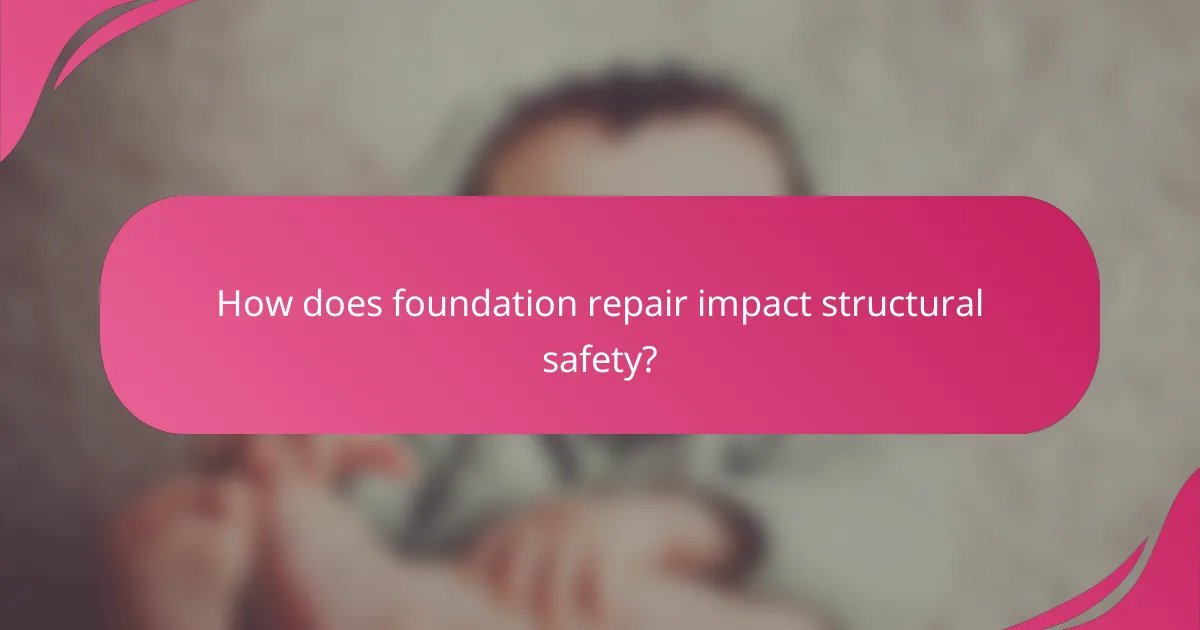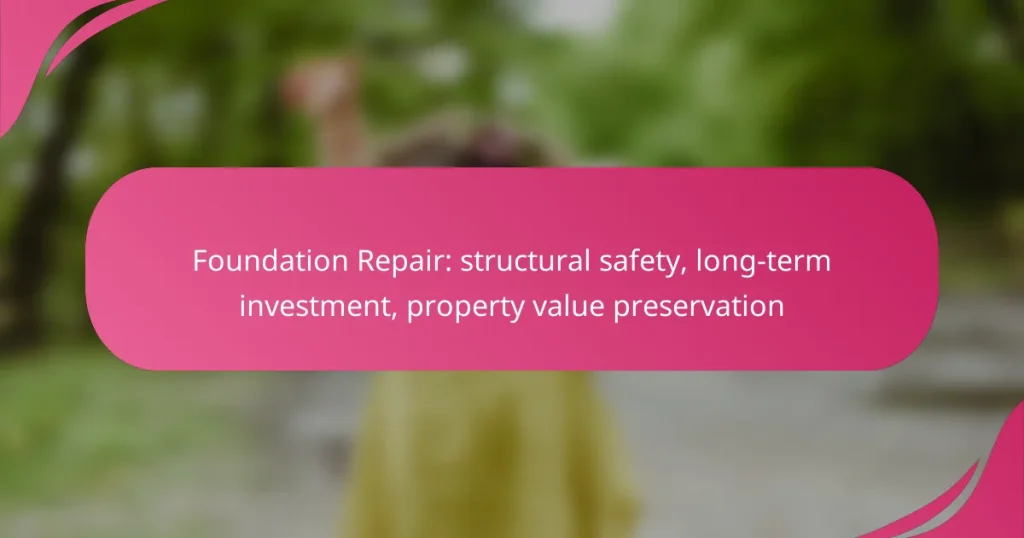Foundation repair is essential for maintaining structural safety and preserving the value of your property. By addressing foundation issues promptly, you not only enhance the integrity of your building but also make a wise long-term investment that can reduce maintenance costs and improve overall comfort. Choosing the right repair method tailored to your specific needs is crucial for achieving lasting results.

What are the best foundation repair methods in Canada?
The best foundation repair methods in Canada include helical piers, concrete underpinning, slab jacking, wall anchors, and foundation replacement. Each method has its own advantages and considerations, making it crucial to choose the right one based on the specific issues and conditions of your property.
Helical piers
Helical piers are steel shafts with helical plates that are drilled into the ground to support the foundation. This method is effective for homes with unstable soil or significant settlement issues. Installation is typically quick, often requiring only a few hours, and it minimizes disturbance to the surrounding area.
When considering helical piers, ensure they are installed by a qualified professional to meet local building codes. This method is suitable for various soil types and can support heavy loads, making it a versatile choice for many homeowners.
Concrete underpinning
Concrete underpinning involves extending the foundation deeper into more stable soil using poured concrete. This method increases the foundation’s load-bearing capacity and is ideal for homes experiencing severe settlement or structural issues. It is a more permanent solution compared to other methods.
While effective, concrete underpinning can be more time-consuming and costly, often requiring several days to complete. Homeowners should budget for potential additional costs related to excavation and site restoration.
Slab jacking
Slab jacking is a technique used to lift and stabilize sunken concrete slabs by injecting a mixture beneath them. This method is particularly useful for repairing uneven floors or driveways. The process is relatively quick, usually taking just a few hours to complete.
When opting for slab jacking, ensure the material used for injection is appropriate for your specific soil conditions. This method is generally less invasive and more affordable than full foundation replacement, making it a popular choice for many homeowners.
Wall anchors
Wall anchors are used to stabilize bowing or leaning basement walls by anchoring them to the soil outside the foundation. This method is effective in preventing further movement and can often be installed with minimal disruption to the interior of the home.
Installation typically requires a professional to assess the wall’s condition and determine the best anchor placement. Wall anchors can be a cost-effective solution for homes with minor to moderate wall movement, but they may not be sufficient for severe structural issues.
Foundation replacement
Foundation replacement is the most extensive and costly option, involving the complete removal and rebuilding of the foundation. This method is necessary when the existing foundation is severely damaged or compromised beyond repair. While it provides a fresh start, it can take several weeks to complete.
Homeowners should consider this option only after evaluating all other repair methods. It’s essential to work with experienced contractors who can ensure the new foundation meets local building codes and is built to last.

How does foundation repair impact structural safety?
Foundation repair significantly enhances structural safety by addressing issues that compromise a building’s integrity. When a foundation is repaired, it stabilizes the structure, preventing further deterioration and potential collapse.
Prevents further damage
Repairing a foundation stops existing issues from worsening, which can lead to costly repairs down the line. For example, cracks in the foundation can allow water intrusion, leading to mold and structural weakening. Timely intervention can save homeowners from expenses that could reach thousands of dollars.
Regular inspections can help identify early signs of foundation problems, such as uneven floors or wall cracks. Addressing these issues promptly can prevent more extensive damage and preserve the overall health of the property.
Ensures stability
A repaired foundation provides a stable base for the entire structure, ensuring that it remains level and secure. Stability is crucial for the safety of occupants and the longevity of the building. For instance, a sinking foundation can lead to misaligned doors and windows, affecting usability.
Homeowners should consider professional assessments to determine the best repair methods, such as underpinning or slabjacking, which can effectively restore stability. Choosing the right approach is essential for long-term success.
Enhances safety
Foundation repair directly enhances safety by reducing the risk of structural failures that could endanger occupants. A compromised foundation can lead to hazardous conditions, such as falling walls or collapsing ceilings. Ensuring a solid foundation minimizes these risks.
Investing in foundation repair not only protects the physical safety of residents but also contributes to peace of mind. Homeowners should prioritize repairs to maintain a safe living environment and comply with local building codes, which often mandate certain safety standards.

What are the long-term benefits of foundation repair?
Foundation repair offers significant long-term benefits, including enhanced structural safety, increased property value, and reduced maintenance costs. Addressing foundation issues promptly not only safeguards your investment but also ensures a comfortable living environment.
Increases property value
Repairing a foundation can substantially boost your property’s market value. Homes with solid foundations are more attractive to potential buyers, as they signify stability and safety. In many cases, properties with foundation issues may sell for tens of percent less than their repaired counterparts.
Investing in foundation repair can yield a positive return, especially in competitive real estate markets. A well-maintained foundation reassures buyers, making your property stand out and potentially leading to quicker sales.
Reduces future repair costs
Addressing foundation problems early can prevent more extensive and costly repairs down the line. Ignoring minor issues can lead to significant structural damage, resulting in expenses that can reach thousands of dollars. By investing in foundation repair now, you can save on future costs and avoid the stress of emergency repairs.
Regular maintenance and inspections can help identify potential issues before they escalate. Consider scheduling annual check-ups with a professional to ensure your foundation remains in good condition and to catch any emerging problems early.
Improves livability
A stable foundation directly contributes to a comfortable living environment. Foundation issues can lead to uneven floors, cracks in walls, and other structural problems that affect daily life. By repairing your foundation, you enhance not only the safety but also the overall comfort of your home.
Additionally, a repaired foundation can improve energy efficiency by ensuring proper insulation and reducing drafts. This can lead to lower utility bills and a more pleasant atmosphere, making your home a better place to live.

What factors influence foundation repair costs in Canada?
Foundation repair costs in Canada are influenced by several key factors including the type of repair method, the extent of damage, and the location of the property. Understanding these elements can help homeowners anticipate expenses and make informed decisions regarding their foundation issues.
Type of repair method
The method chosen for foundation repair significantly affects costs. Common methods include underpinning, slab jacking, and wall anchors, each with varying price points. For instance, underpinning can range from CAD 1,000 to CAD 3,000 per section, while slab jacking might cost between CAD 500 and CAD 1,500 depending on the area being treated.
When selecting a repair method, consider the long-term effectiveness and potential need for future repairs. Some methods may offer more durable solutions but come with higher initial costs.
Extent of damage
The severity of foundation damage directly correlates with repair costs. Minor cracks may only require sealing, costing a few hundred dollars, while extensive structural issues could lead to expenses in the tens of thousands. Homeowners should assess the damage thoroughly to determine the necessary repairs.
It’s advisable to obtain multiple assessments from professionals to understand the full scope of the damage and the associated costs. This helps in avoiding unexpected expenses during the repair process.
Location of property
The geographical location of a property in Canada can influence foundation repair costs due to varying soil conditions, local labor rates, and regional regulations. For example, properties in areas with expansive clay soils may require more extensive repairs, increasing costs.
Additionally, urban areas may have higher labor costs compared to rural locations, which can further affect the overall price. Homeowners should consider these factors when budgeting for foundation repairs to ensure they are adequately prepared.

What signs indicate a need for foundation repair?
Signs that indicate a need for foundation repair include visible cracks in walls and uneven floors. These issues can compromise structural safety and may lead to more significant problems if not addressed promptly.
Cracks in walls
Cracks in walls are a common indicator of foundation issues. They can appear as vertical, horizontal, or diagonal lines and may vary in size from hairline fractures to wider gaps. It’s essential to monitor the progression of these cracks, as widening or deepening cracks often signal worsening foundation problems.
When assessing cracks, consider their location and direction. For instance, vertical cracks may be less concerning than horizontal ones, which can indicate more severe structural shifts. If cracks exceed a quarter-inch in width, it is advisable to consult a foundation repair specialist.
Uneven floors
Uneven floors can be another clear sign of foundation trouble. If you notice sloping, bouncing, or sagging floors, it may indicate that the foundation is settling or shifting. This can lead to further complications, including damage to flooring materials and increased risk of structural failure.
To evaluate floor unevenness, use a level to check for slopes. A difference of more than one inch over a span of ten feet is generally considered significant and warrants professional inspection. Addressing uneven floors early can help preserve property value and ensure safety.


